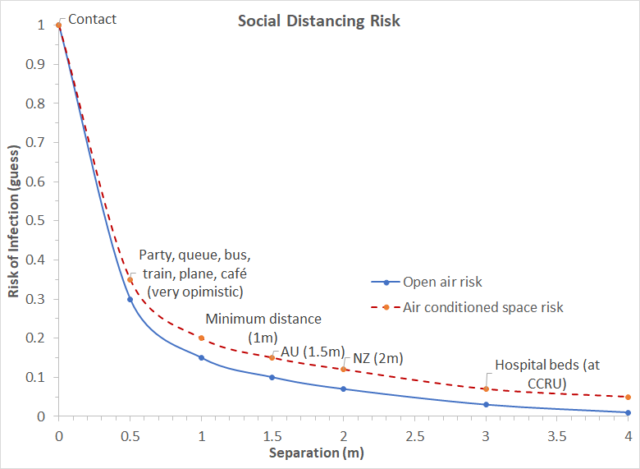This blog is not intended as advice. It is for educational and research purposes only. Read this disclaimer first if you want to read this post.
Until we have a good, effective vaccine or a magic drug, prevention of COVID-19 infections depends largely on the behavior of individuals. Laws and guidelines have been developed, but they do not appear to be specific for COVID-19, but largely draw from the experience of hospital infection control. As they are the main weapons in preventing the spread of COVID-19 it is astounding that they still lack rigor.
These interventions appear to be (I hope to update this post with links)
- Social Distancing – but I was unable to find data for risk at different degrees of social distancing. I have attempted (below) to picture what I think the risks with distance are likely to be. So far it is a guess.
- Hand Sanitizing – It appears that hand sanitizer with a high alcohol content (>70%) kills most virus. Simple washing with soap will loosen and removed dirt, but thorough washing is needed to remove loosened bugs. Hand sanitizing of clean hands appears to be the better option, but frequent hand sanitizing leads to skin damage and potential secondary infections.
- Face Masks – are a cesspit of misinformation, conflicting advice and ignorance. Though any mask lessens face touching, wearers tend to frequently adjust the mask as slips. This means inoculation of the face by infected fingers and inoculation of the fingers by COVID-19 filtered by the mask. The Cochrane Review of surgical masks found they made little difference to post operative infection rates. The WHO recommendation of simple cloth masks has further muddied the water.
- Gloves – When you wear gloves, washing of the gloved hand does not occur, but face touching decreases. If COVID-19 survival if less on slightly salty bare skin (that is regularly sanitized), then gloves serve as efficient innoculators and makes things worse.
- Sneeze screens – I have done work in this area and found that there is no rigorous research into the efficacy of sneeze screens. The work I did for one client suggested that sneeze screen s could make things worse as passing air curls around the screen straight into the face of the worker.
In the absence of a proper, peer reviewed article of the reduction of risk with social distancing, this is what the shape of the risk reduction with distance would look like for open air and air conditioned spaces.

The two curves represent what I thing the risk of infection against social distance may be for open air and air conditioned (AC) spaces.
- Zero distance – contact, when the risk is high and would approach 100%. Effective zero distance would be achieved after touching fomites (infected surfaces) and then touching the face (or infecting another surface like a hand rail).
- 0.5 m – a typical distance found at a party, crowded public transport, cafe, demonstration. Inadvertent or deliberate skin contact may also occur.
- 1 m – suggested my some as the minimum social distancing. Deliberate skin contact may occur. Limited protection from infectious aerosols would occur.
- 1.5m – social distancing mandated in Australia and some other countries. This would largely avoid skin contact and reduce
- 2m – social distancing in NZ. Skin contact would be rare and deliberate. A slightly greater infectious aerosol protection would be obtained.
- 3m – I believe this was the optimum bed separtion distance that the Common Cold Research Unit found in UK post WWII. I have been unable to verify this.
The separate dashed curve for air conditioned spaces indicates the slightly high risk that occurs through recycling of air. The air filtration is coarse and only specialized laboratories and purpose built facilities have HEPA filtration. Hospitals and cruise ships recycle air.
I try to avoid air-conditioned spaces, crowded areas (including queues, trains, buses and aircraft), maintain at least 1.5 social distancing from strangers, use hand sanitizer and wash by hands a lot more. I do not use gloves or a face mask. I can never expect 100% protection.
